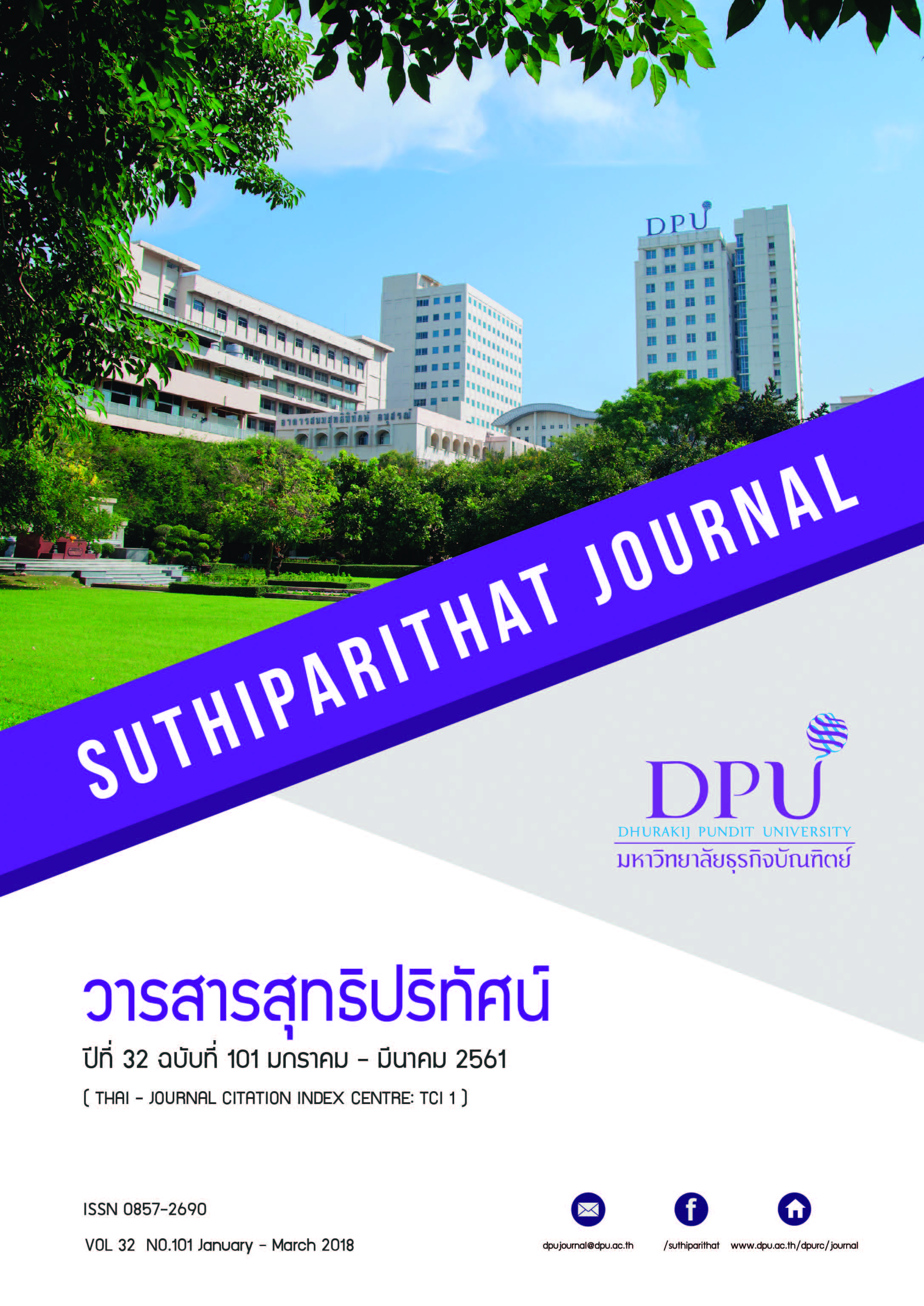กลยุทธ์การแสวงหาข้อมูลของพนักงานใหม่ในกระบวนการ เข้าเป็นส่วนหนึ่งขององค์การ
คำสำคัญ:
กลยุทธ์การแสวงหาข้อมูลข่าวสาร, กระบวนการเข้าเป็นส่วนหนึ่งขององค์การบทคัดย่อ
วัตถุประสงค์ของการศึกษาครั้งนี้ต้องการศึกษาถึงกลยุทธ์การแสวงหาข้อมูลข่าวสารของพนักงานใหม่ในกระบวนการเข้าสู่องค์การ โดยกำหนดกลุ่มตัวอย่างเป็นพนักงานที่ร่วมเป็นอาสาสมัครทำกิจกรรมขององค์การ มีจำนวนทั้งสิ้น 245 คน เครื่องมือที่ใช้ในการศึกษา ครั้งนี้คือ แบบสอบถาม และใช้ Repeated measures analysis ในการวิเคราะห์ข้อมูลทางสถิติ ผลการศึกษา พบว่า สมมติฐานได้รับการสนับสนุน กลยุทธ์การแสวงหาข้อมูลข่าวสารที่พนักงานใหม่เลือกใช้ในการรับรู้ข้อมูลข่าวสารเพื่อลดความไม่แน่นอนในการทำงานคือ การสอบถามโดยตรง และการสังเกต ซึ่งก็สอดคล้องกับระบบการทำงานในวัฒนธรรมไทยแบบใหม่ที่พนักงานส่วนใหญ่มักจะแสวงหาข้อมูลหรือรูปแบบการปฏิบัติงาน ด้วยการสอบถามโดยตรง หลังจากนั้นก็ใช้วิธีการสังเกตถึงแบบแผนในการปฏิบัติงาน
เอกสารอ้างอิง
Argyle, M., & Furnham, A., & Graham, J. (1981). Social Situation. Cambridge, MA: Cambridge University Press.
Argyris, C., & Schan, D. (1978). Organizational learning: A theory of action perspective. Reading, MA: Addison-Wesley.
Ashford, S. J. (1986). The role of feedback seeking in individual adaptation: A resources perspective. Academy of Management Journal, 29, 465-487.
Ashford, S. J., & Cumming, L. L. (1985). Proactive feedback seeking: The instrumental use of the information environment. Journal of Occupational Psychology, 58, 67-79.
Berger, C. R. (1979). Beyond initial understanding: Uncertainty, understanding, and the development of interpersonal relationship. In H. Giles & H. N. St. Clair (Eds.), Language and social psychology (pp. 122-124). Oxford: Basil Blackwell.
Berger, C. R., & Bradac, J. J. (1982). Language and social knowledge: Uncertainty in interpersonal relations. London: Edward Arnold.
Berger, C. R., & Calabrese, R. J. (1975). Some explorations in initial interaction and beyond: Toward a developmental theory of interpersonal communication. Human Communication Research, 1, 99-112.
Berger, C. R., Gardner, R. R., Parks, M. L., Schulman, L. W., & Miller, G. R. (1976). Interpersonal epistemology and interpersonal communication. In G. R. Miller (Eds.), Explorations in interpersonal communication (pp. 149-171). Newbury Park, CA: Sage.
Comer, D. R. (1991). Organizational newcomers’ acquisition of information from peers. Management Communication Quarterly, 5, 64-89.
Dervin, B. (1993). An overview of sense-making research: Concepts, methods and results to date. Paper presented at the 31st International Communication Association Convention, Texas, USA.
Falcione, R. L., & Wilson, C. E. (1988). Socialization processes in organizations. In G. Goldhaber & G. Nernett (Eds.), Handbook of organizational Communication (pp. 151-169). New York: Ablex.
Gorden, W. I. & Mignerey, J. T., Rubin, R. B. (1995). Organizational entry: An investigation newcomers communication behavior and uncertainty. Communication Research, 22, 54-85.
Hughes, E. C. (1958). Men and their work. New York: The Free Press.
Jablin, F. M. (1987). Organizational entry, assimilation, and exit. In F. M. Jablin, L. L. Putnam, K. Roberts, & L. Porter (Eds.), Handbook of organizational communication (pp. 679-740). Newbury Park, CA: Sage.
Jablin, F., & Krone, K. (1987). Organization assimilation. In C. Berger & S. Chaffee (Eds.), Handbook of communication science (pp. 711-746). Newbury Park, CA: Sage.
Jones, G. R. (1983). Psychological orientation and the process of organizational socialization: An interactionist perspective. Academy of Management Review, 8, 464-474.
Jones, G. R. (1986). Socialization tactics, self-efficiency, and newcomer’s adjustment to the organization. Academy of Management Journal, 29, 262-279.
Louis, M. R. (1980). Surprise and sense making: What newcomers experience in entering unfamiliar organizational settings. Administrative Science Quarterly, 25, 226-251.
Miller, V. M. (1989). A quasi-experimental study of newcomer’s information-seeking behaviors during organization entry. Top three paper presented at the 37th International Communication Association Annual Convention, Organizational Communication Division, San Francisco, USA.
Miller, V. M. & Jablin, F. M. (1991). Information seeking during organization entry: Influence, tactics, and a model of the press. Academy of Management Review, 16, 92-120.
Morrison, E. W. (1991). An investigation of mode and source usage in the newcomer information seeking process. In J. Wall & L. Jauch (Eds.), Best papers proceedings of the 51st Annual Meeting of the Academy of Management, 225-229. Miami Beach, Florida, USA.
Morrison, E. W. (1993b). A longitudinal study of newcomers information seeking: Exploring types, modes, sources, and outcomes. Academy of Management Journal, 36, 557-589.
Norton, R. (1975). Measurement of ambiguity tolerance. Journal of Personality Assessment, 39, 607-619.
Petelle, J., Jorgensen, J., & Slaughter, G. (1991). Uncertainty within the organizational: Hierarchical differences of uncertainty and reduction strategies. Paper presented at the 39th International Communication Association Convention, Chicago, USA.
Schein, E H. (1968). Organizational socialization and the professional management. Industrial Management Review, 9, 1-6.
Teboul, J. B. (1994). Encounting the organization: facing and coping with uncertainty during organizational encounter. Management Communication Quarterly, 8, 190-224.
ดาวน์โหลด
เผยแพร่แล้ว
รูปแบบการอ้างอิง
ฉบับ
ประเภทบทความ
สัญญาอนุญาต
เนื้อหาและข้อมูลในบทความที่ลงตีพิมพ์ในวารสารสุทธิปริทัศน์ ถือเป็นข้อคิดเห็นและความรับผิดชอบของผู้เขียนบทความโดยตรงซึ่งกองบรรณาธิการวารสาร ไม่จำเป็นต้องเห็นด้วย หรือร่วมรับผิดชอบใด ๆ
บทความ ข้อมูล เนื้อหา รูปภาพ ฯลฯ ที่ได้รับการตีพิมพ์ในวารสารสุทธิปริทัศน์ ถือเป็นลิขสิทธิ์ของวารสารสุทธิปริทัศน์หากบุคคลหรือหน่วยงานใดต้องการนำทั้งหมดหรือส่วนหนึ่งส่วนใดไปเผยแพร่ต่อหรือเพื่อกระทำการใด ๆ จะต้องได้รับอนุญาตเป็นลายลักษณ์อักษรจากวารสารสุทธิปริทัศน์ก่อนเท่านั้น







